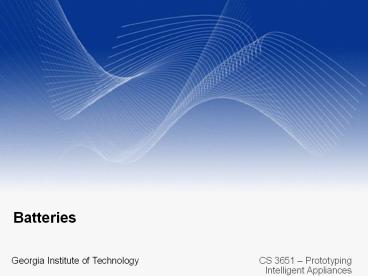Batteries PowerPoint PPT Presentation
Title: Batteries
1
Batteries
Georgia Institute of Technology
2
How Electrochemical Batteries Work
- REDOX Reaction
- Oxidation, the loss of electrons, occurs at the
anode. - Reduction, the gain of electrons, occurs at the
cathode.
Electron Flow ?
Salt Bridge
Anode
Cathode
-
-
-
-
Electrolyte
Electrolyte
3
Electrochemical Battery History
- Baghdad Batteries
- 1000-2000 years ago.
- Terracotta jars containing a copper cylinder
separated from an iron rod by a non-conductive
stopper, and filled with an electrolyte. - Debated uses electroplating, experiencing God
4
Electrochemical Battery History Contd
- The Voltaic Pile
- Invented by Alessandro Volta in 1800
- Zinc and Copper with a cloth soaked in brine
- Technical Flaws
- Compressing of cloth created shorts
- Short battery life
- The Daniel Cell
- Invented in 1836 by John Daniell
- The lead-acid cell
- Invented in 1859 by Gaston Planté
- First rechargeable battery
- The zinc-carbon cell
- Invented in 1887 by Carl Gassner
5
Electrochemical Battery History Contd
- The Nickel-Cadmium Battery
- Invented in 1899 by Waldmar Jungner.
- The common Alkaline Battery
- Invented in 1955 by Lewis Urry
- The Nickel Metal-Hydrid Battery
- NiMH batteries for smaller applications started
to be on the market in 1989. - Lithium and Lithium-ion Batteries
- First lithium batteries sold in the 1970s
- First lithium-ion batteries sold in 1991
- First lithium-ion polymer batteries released in
1996
6
Quick Overview of Other Batteries
- Mercury Battery
- Shelf life of up to 10 years.
- Silver-Oxide Battery
- Prohibitive costs, but excellent energy density.
- Atomic Batteries
- Thermionic Converter
- Thermophotovoltaic Cells
- Reciprocating Electromechanical Atomic Batteries
- Betavoltaics
- Use energy from atom decay emitting beta
radiation - Used for remote and long-term needs, e.g.
spacecraft
7
Terminology and Units
- Primary Batteries Disposable
- Secondary Batteries Rechargeable
- emf Electromotive force, voltage
- Amperehour (Ah) 3600 coulombs, a measure of
electric charge - Watt hour (Wh) 3600 joules, a measure of
energy - Ah (Wh) / emf
8
Primary Alkaline Batteries
- Can lose 8 20 charge every year at room
tempurature. - Discharge performance drops at low temperatures.
AAA AA 9V C D
Capacity (Ah) 1.250 2.890 0.625 8.350 20.500
Voltage 1.5 1.5 9 1.5 1.5
Energy (Wh) 1.875 4.275 5.625 12.525 30.75
9
Secondary Alkaline Batteries
- Self-discharge more quickly than primary
batteries - Must not overcharge because that will damage the
batteries. Quick charges will also damage the
batteries. - Must not over-discharge.
- NiCd has memory effect.
- NiCd is better for applications where current
draw is less than the batterys own
self-discharge rate. - NiMH have a higher capacity, are cheaper, and are
less toxic than NiCd.
Low-Capacity NiMH (1700-2000 mAh) High-Capacity NiMH (2500 mAh) NiCd
Charge Cycles 1000 500 1000
10
Lithium-Ion and Lithium-Ion Polymer Batteries
- Great energy-to-weight ratio (160 Wh/kg compared
to 30-80 Wh/kg in NiMH) - No memory effect.
- Slow self-discharge rate.
- Battery will degrade from moment it is made.
- Protection circuits are required to protect the
battery. - Li-Ion Polymer batteries are significantly
improved. - Higher energy density.
- Lower manufacturing costs
- More robust to physical damage
- Can take on more shapes.

